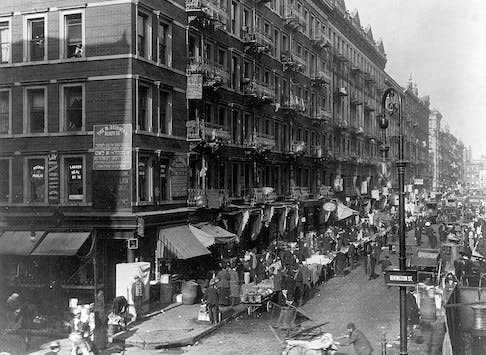Novel Presents a Shakespearean Lower East Side, With a Large Dose of Henry James
The novel is so steeped in the Lower Manhattan of the early 20th century that you want to say to the author, Jerome Charyn: ‘Surely you did not make this up.’

‘Ravage & Son’
By Jerome Charyn
Bellevue Literary Press, 288 pages
Abraham Cahan (1860-1951), a founding editor of the Jewish Daily Forward, is the moral center of “Ravage & Son,” a novel so steeped in turn of the century Lower Manhattan that you want to say to Jerome Charyn: “Surely you did not make this up.”
The spirit of Henry James, who makes a cameo appearance in the novel, hovers over the action. Like one of James’s narrators, the voice of “Ravage and Son” inhabits Cahan’s sensibility, as he uses his newspaper not only to hold together his community by telling the stories of its lives and occupations, but also to oppose the Woolworths of the world that will standardize commerce and destroy the small businesses of the Lower East Side.
Cahan cannot prevail, yet his example is inextinguishable in Mr. Charyn’s prose as an organ that provides a dignity and purpose to Jewish life, which is why he is called “The Baron of East Broadway,” where the Forward offices are situated. Cahan is set against the machinations of Lionel Savage, a pipe manufacturer who sewers the city, so to speak, presiding over a corrupt polity even as he also, like other Jewish barons, is one of the driving forces of the city that his son, turned a detective, combats.
In Mr. Charyn’s novel, Cahan meets James when he visits the Lower East Side, about which the novelist then writes with distaste in his book, “The American Scene.” Cahan reveres James and is outraged at the master’s failure to understand the great potential of immigrants, no matter how crowded and degraded they appear to be in James’s pages.
Mr. Charyn’s Cahan writes James letters objecting to “The American Scene” but does not send them. Why? Because Cahan, also a novelist, has learned so much from James and cannot bear to cancel him.
The menace and violence in this novel is savage. What happens to Ravage and his son, I don’t want to say, except that their fate is exquisitely unbearable but absolutely necessary to this novel.
As brutal as life seems on the Lower East Side — one that degrades women into white slavery, compels, it seems, almost every cop to be on the take, and evicts the poor and tosses them out in the streets — another side abides.
Landlord Lionel enthralls a housewife into bed by quoting Shakespeare, easily shifting from Prospero to Caliban. His son Ben watches Clara Karp play Hamlet in Yiddish: “She didn’t usurp Shakespeare she limbed his lines, repeated soliloquies, attacked time and again with her rapier, like some colossal assassin.”
Clara is “courted by millionaires and penniless poets, and not one of them could touch that quaking world inside her belly.” Poets scribble odes to her, but only Shakespeare and the boy genius Ben Savage “breathe a little fire into her loins.”
Such passages evoke the Shakespearean Lower East Side — one that Henry James could not have imagined in his philosophy. When Ben claims Clara is as great as Sarah Bernhardt, she disclaims the comparison, attributing her popularity to mixing Shakespeare with “shund” (low culture), and Ben is aghast because he has always felt so ennobled and erotic in her presence.
Is it one or the other? Shund or high art? Could Ben, a reader of Henry James, get Clara so wrong? You will have to read the novel and decide for yourself. For me, the division James saw between himself and the Lower East Side — without being sentimental about it — is not so easily established.
The prose of this novel pulsates in a relentless torrent that will give you some idea of why Cahan had to write it all up and why Mr. Charyn has to do the same for Cahan.
By the end, the Lower East Side, as it has been depicted in the novel, no longer exists, and a kind of spell is broken as Clara reads Henry James to Ben, who can no longer read the master himself.
Why? Oh, that would give way too much away. You have to earn that knowledge by reading the novel and realizing how one world makes way for the next — to ours.
Mr. Rollyson’s New York can be found in his biographies of Marilyn Monroe, Lillian Hellman, Norman Mailer, Rebecca West, William Faulkner, Sylvia Plath, and Susan Sontag.

